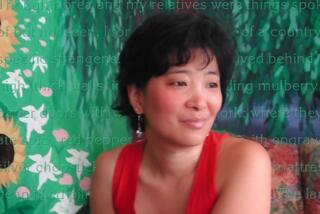‘The Shaking Woman or a History of My Nerves’ by Siri Hustvedt
The Shaking Woman
Or a History of My Nerves
Siri Hustvedt
Henry Holt: 224 pp., $23
The shaking began 2 1/2 years after her father died. Siri Hustvedt was giving a talk at the university where he taught in the town in which she had spent a piece of her childhood. As she began speaking, her limbs began to tremble uncontrollably. She kept on with her talk and the trembling disappeared, but it came back at other public speaking events or after considerable exertion -- for example, hiking in the Pyrenees.
Hustvedt became, if only in her own mind, “the shaking woman”: “From the chin up, I was my familiar self. From the neck down, I was a shuddering stranger.” Unlike the migraines she has endured since childhood, the shaking causes a split in her self. “My narrating, first-person subject seems to go in one direction and my recalcitrant body in another, which illustrates the fact that I locate myself through that inner voice.” She thinks of the shaking woman as “an untamed other self, a Mr. Hyde to my Dr. Jekyll.”
And so the writer bursts from the starting gate, armed with considerable, penetrating intelligence, her creativity, her addiction to reading and research. She is going to figure this out, even as psychologists and psychiatrists and neurologists are stumped. She is going to tell this story, and in the telling maybe heal herself. She is, as a friend points out, “a doctor and a patient in the same body.”
If you haven’t read Hustvedt’s novels or nonfiction (she’s also written one collection of poems), I recommend “The Sorrows of an American.” It’s one of those novels that has an enduring ripple effect throughout a reader’s life -- that eerie, indelible sense of a room you think you’ve been in, or a response to a situation that echoes in your mind years after you’ve read it. Hustvedt didn’t get there by accident. She has traveled for years in the halls of the great subconscious, and we readers meet her there as she rushes by us in the white coat worn by authors.
In the absence of a diagnosis, Hustvedt considers the possibility of hysteria, now called conversion disorder, but that is dismissed when she offers it to doctors as a possible explanation. She believes the shaking relates to her father’s death -- she considers it a mystical, supernatural explanation. She writes that all her life she has exhibited a tendency to “feel too much,” to attribute too much meaning to things, to be too intense for everyday conversation and social interaction. Someone suggests the possibility (not relating to the shaking but to Hustvedt’s pronounced empathy) that she has mirror touch synesthesia, an extreme sensitivity to other people’s sensitivities, and this makes sense, but again, it does not explain the shaking.
Beta-blockers help her to get through most speaking engagements. Her continued research has an oddly pragmatic tone, perhaps because we are not used to reading diagnoses in the first person. (Behavior, she points out, is usually described in the third.) But the first-person autobiographical core of the book feels strangely rational and removed, as if we were watching Hustvedt diagnose and then operate on her own body. There’s no end to the memoirs of illness out there, but this one is different. There’s a nakedness to it -- Hustvedt reveals as much about herself as she can, but it is not everything because she does not know everything. Some critical piece is missing. It could be physical (something for an episode of “House”), or it could be emotional (the reader can’t help but wonder whether she was traumatized at some point in her childhood) or it could be spiritual (Hustvedt, empathic author, is a mystic).
This is a curious book. Curiouser and curiouser as Hustvedt reveals her symptoms -- the “history” of her nerves: traumatic flashbacks (in particular after a car accident), oceanic euphoria, migraines, febrile convulsions as an infant and hearing voices, beginning when she was 11 or 12.
The reader feels her reluctance to divulge these symptoms and her reluctance to answer the question: Why do I shake? “I have a vague sense that there are hidden recesses of my personality that I am reluctant to penetrate.” She settles for ambiguity, but too happily. The shaking, like the migraines, she writes, have become a part of her story, history and identity.
Hustvedt admires writers who have explored consciousness and the neurological aspects of identity tenderly, like William James and Oliver Sachs, writers who use story and context to explain character. She is put off by the overly pragmatic: “[M]uch of science (as well as much of analytical philosophy) proceeds from an anonymous third-person view of a paralyzed world, which can then be broken down into legible truths.” And yet she looks at her own discomfort as if she were holding it in the palm of her hand. Is this merely a symptom of authorship? Of a lifetime spent describing and imagining and containing within the covers of books? Perhaps. But something ghostly still walks in these pages. And you can see it in Hustvedt’s novels as well. Something beautiful and ghostly and unexplained. Of course, it’s one thing to read about it. It’s another to live with it.
Salter Reynolds is a writer living in Los Angeles.
More to Read
The biggest entertainment stories
Get our big stories about Hollywood, film, television, music, arts, culture and more right in your inbox as soon as they publish.
You may occasionally receive promotional content from the Los Angeles Times.






